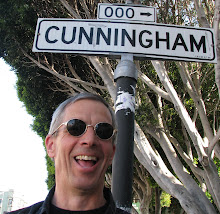I have a few quilts in a show that recently opened at the Craft and Folk Art Museum--"CAFAM"--in Los Angeles. Man Made is a show of quilts by, guess what: men! Is there a need for a show like this? I don't know. Gender specific shows leave me cold, usually, because gender is such a vague thing to fit a bunch of artists into. I mean, just because we are all of the same gender is no reason to think that our work will have anything interesting to say when it is all thrown together. And as I have said over and over, while there were a few men in the business when I got started at the end of the 1970's, my real heroes in the quilt world have all been women. Of course! Quilts were defined in the USA as a gender specific realm of women, by women, for women to make gifts for people they loved. Naturally, then, it was women I looked up to and was inspired by.
But this idea of men making quilts is hot right now. There is the freak show angle, the burning question of what kind of weirdo would to do this anyway? And there is the idea that quilts want to be modern, that they want to be brought out of the past, and people are casting around for ways to do that. Looking at quilts by men is a short cut to this, a way of seeing them as something radically new.
And there are the men themselves, some of them young and sexy like Luke Haynes, or Ben Venom, Aaron McIntosh or Jimmy McBride, or well, all the guys who are young. These guys have been to art school and have the ability to frame what they are doing in high-enough-faluting prose to lend a sort of conceptual art gloss to the whole enterprise.
I think it all feeds into the strain of thinking that has been there ever since this revival started in the early 1970's, the idea that making a quilt is too confining, that we need to "get out of the box," to have "Tradition with a twist!" or to break the bonds of tradition. This idea has persisted, even though there has never been another tradition that is less confining. Regardless of what some stodgy traditionalists may have thought, the very notion of a quilt is that it can look like anything you want, as the women of the 19th and 20th centuries have shown us over and over. It is not a box within which we must stay; quiltmaking is a doorway to a realm where we have the privilege of making anything we can conceive.
The guys in this show demonstrate that. But it would have been extremely easy to find 8 women to demonstrate the same thing. And for the women who have complained that a show of 8 women quilters would not have received any of the significant press this one has, I would say they are correct. So, that is one reason a museum would choose to have a show of quilts by men; its newsworthiness.
I have also heard the complaint that women can make great quilts all their lives and never get any recognition for it, but if a man makes one quilt he becomes a rock star. All I have to say about that is that I do not think anyone in the business becomes a rock star easily. A man might have it easier to get notice in the beginning, but even a man has to do the work of making something amazing and different to get noticed in the long run. And I do not think any man goes into quilts to have an advantage over anyone else. Making quilts is just something that grabs you, regardless of your gender. No one goes into it hoping to become powerful.
So, the show has opened and I had a chance to spend time in it and see what I thought. I am probably too biased to have anything of value to say about it, but I would still say that I think it is an interesting way to spend some of your time. The quilts are varied enough that it would be hard to become bored at the show. It turns out that it will be traveling to Asheville NC and Lincoln, NE in the next year and a half. So if you live near either of those towns you will have a chance to see for yourself. I would love to hear what you think.
 Sculpture just lying around
Sculpture just lying around My favorite bistro, for obvious reasons
My favorite bistro, for obvious reasons
 Sculpture just lying around
Sculpture just lying around My favorite bistro, for obvious reasons
My favorite bistro, for obvious reasons

























